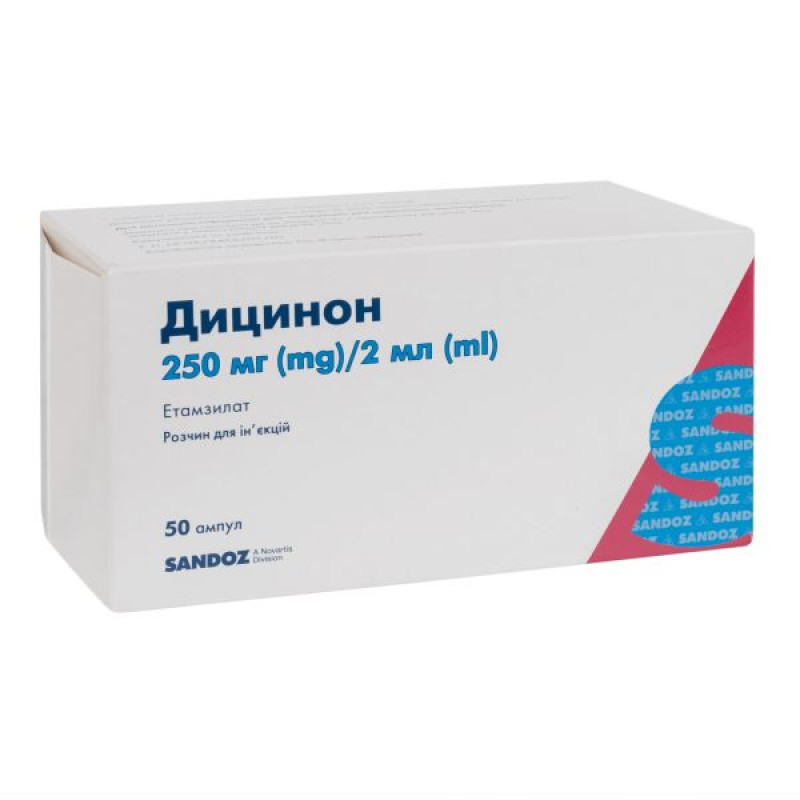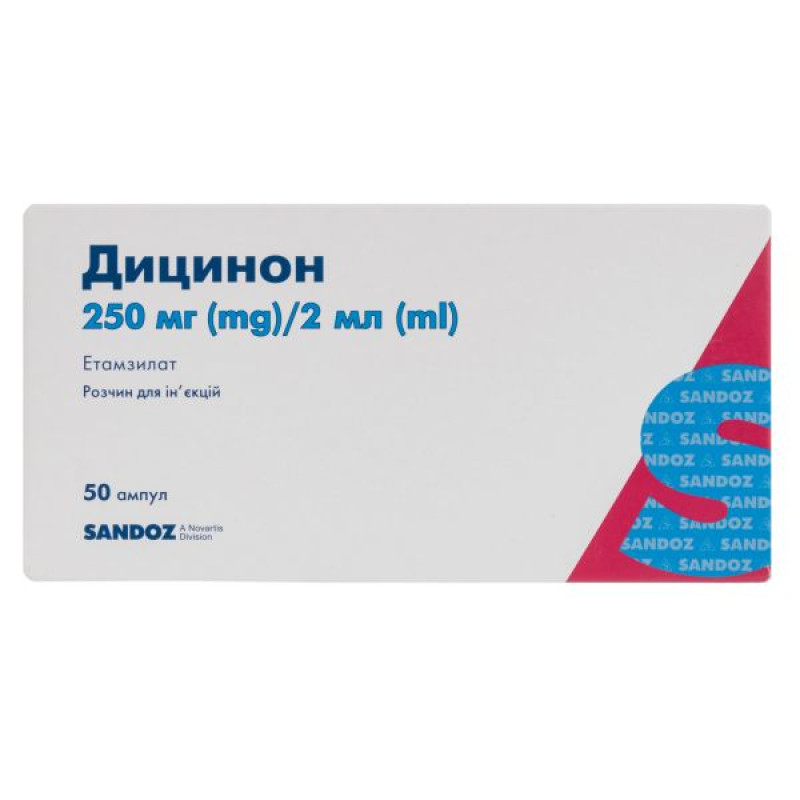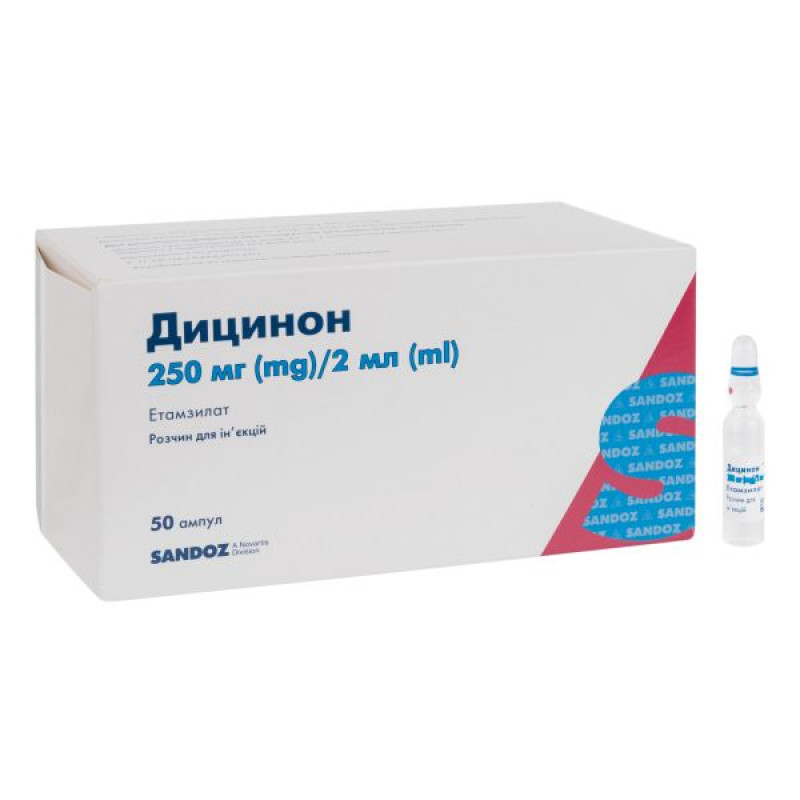Dicinon solution for injection 250 mg ampoule 2 ml No. 50

Instructions Dicinon solution for injection 250 mg ampoule 2 ml No. 50
Composition
active ingredient: etamzilate;
1 ampoule (2 ml of solution) contains 250 mg of etamsylate;
Excipients: sodium metabisulfite (E 223), sodium bicarbonate, water for injections.
Dosage form
Solution for injection.
Main physicochemical properties: colorless transparent solution, practically free of visible particles.
Pharmacotherapeutic group
Antihemorrhagic agents. Other hemostatic agents for systemic use.
ATX code B02B X01.
Pharmacological properties
Pharmacodynamics
Etamzilat is a means for preventing and stopping bleeding. It affects the first stage of the hemostasis mechanism (interaction between the endothelium and platelets). Dicinone increases platelet adhesion, normalizes the stability of capillary walls, thereby reducing their permeability, inhibits the biosynthesis of prostaglandins, which cause platelet disaggregation, vasodilation and increased capillary permeability. As a result, the bleeding period is significantly reduced, blood loss is reduced.
Pharmacokinetics
After intravenous administration of the drug, the hemostatic effect is noted after 5-15 minutes, the maximum is reached within 1 hour. The maximum concentration of etamsylate in the blood plasma is reached after 1 hour after intravenous or intramuscular administration of 500 mg of Dicinon and is 30-50 μg/ml. Approximately 90% of the drug binds to blood plasma proteins.
Approximately 72% of the administered dose is excreted unchanged in the urine within the first 24 hours. The plasma half-life of etamsylate is approximately 2 hours. Etamsylate crosses the placental barrier. It is unknown whether etamsylate is excreted in breast milk.
Indication
Prevention and control of hemorrhages in superficial and internal capillaries of various etiologies, especially if the bleeding is caused by damage to the endothelium, in particular:
prevention and treatment of bleeding during and after surgical operations in otolaryngology, gynecology, obstetrics, urology, dentistry, ophthalmology and plastic surgery; prevention and treatment of capillary bleeding of various etiologies and localizations: hematuria, metrorrhagia, primary hypermenorrhea, hypermenorrhea in women with intrauterine contraceptives, nosebleeds, bleeding gums; neonatology: prevention of periventricular bleeding in premature infants.
Contraindication
Hypersensitivity to etamzilate or any other ingredient of the drug (especially to sodium metabisulfite); bronchial asthma; acute porphyria; increased blood clotting, thrombosis, thromboembolism; hemoblastosis (lymphatic and myeloid leukemia, osteosarcoma) in children.
Interaction with other medicinal products and other types of interactions
Thiamine (vitamin B1) is inactivated by sulfite contained in the Dicinon solution.
The use of etamsylate 1 hour before the administration of dextrans (e.g., rheopoliglyukin) prevents their antiplatelet effect; after the administration of the latter, it does not have a hemostatic effect.
The drug can be used together with other hemostatic agents.
If the etamzilate solution is mixed with 0.9% sodium chloride solution, it must be used immediately.
Application features
Before starting treatment, other causes of bleeding should be excluded. If no improvement is observed when using Dicinon to reduce excessive and/or prolonged menstrual bleeding, possible pathological causes (e.g., the presence of uterine fibroids) should be excluded.
The drug should be used with caution in patients with a history of thrombosis or thromboembolism.
Given the risk of a drop in blood pressure during parenteral administration of the drug, it should be used with caution in patients with unstable blood pressure or arterial hypotension.
If the patient requires infusion of dextrans, etamsylate should be administered prior to the infusion of the latter.
The drug is ineffective with a low platelet count.
In case of hemorrhagic complications associated with anticoagulant overdose, it is recommended to use specific antidotes.
The use of etamzilate in patients with impaired blood coagulation system parameters is possible, but it must be supplemented with the administration of drugs that eliminate the identified deficiency or defect in coagulation system factors.
It is forbidden to use the drug if the color of the injection solution changes.
Dicinon solution contains the antioxidant excipient sodium metabisulfite (E 223). In sensitive patients, sulfites can cause allergic reactions, nausea, diarrhea. Isolated cases of anaphylactic shock and life-threatening asthma attacks have been reported. Hypersensitivity to sulfites is more common in patients with bronchial asthma.
If allergic reactions or high fever occur, treatment should be stopped immediately and a doctor should be informed, as this may be a sign of hypersensitivity.
The safety and efficacy of etamzilate have not been studied in patients with renal insufficiency. Since etamzilate is almost completely excreted by the kidneys, the dose of the drug should be reduced in cases of renal insufficiency. Laboratory tests.
In therapeutic doses, etamzilate may reduce test results when determining creatinine levels.
Ability to influence reaction speed when driving vehicles or other mechanisms
It has no effect, but dizziness may occur when using the drug, which should be taken into account when driving or using other mechanisms.
Use during pregnancy or breastfeeding
There is no reliable data on the effect of Dicinon on the fetus, therefore the drug is contraindicated in the 1st trimester of pregnancy. In the 2nd and 3rd trimesters of pregnancy, the use of the drug is possible if the benefit to the mother outweighs the risk to the fetus.
Breastfeeding should be discontinued when using the drug.
Method of administration and doses
The drug is administered intravenously (slowly) or intramuscularly. The optimal daily dose for adults is 10-20 mg/kg of body weight, which is administered in 3-4 doses (in most cases, the contents of 1-2 ampoules are administered 3-4 times a day).
The daily dose for children is half the dose for adults.
Surgical interventions: 1 hour before surgery, inject the contents of 1-2 ampoules intravenously or intramuscularly. During surgery, inject the contents of 1-2 ampoules intravenously; this dose can be repeated. After surgery, inject the contents of 1-2 ampoules every 4-6 hours until the risk of bleeding disappears.
Neonatology: the drug is administered intramuscularly at a dose of 10 mg/kg body weight (0.1 ml = 12.5 mg). Treatment should be started within the first 2 hours after birth. Then the drug is administered every 6 hours for 4 days to a total dose of 200 mg/kg.
Dicinone can be applied topically (skin graft, tooth extraction) using a sterile gauze pad moistened with the drug. It is possible to combine the oral form of the drug with parenteral administration.
Impaired liver and kidney function. Clinical data are insufficient to recommend a dosage regimen, so the drug should be used with caution in such patients.
Children
The drug is contraindicated in children with hemoblastosis (lymphatic and myeloid leukemia, osteosarcoma).
Overdose
No data available. In case of overdose, treatment is symptomatic.
Adverse reactions
From the nervous system: headache, dizziness, hot flashes, paresthesia of the lower extremities.
From the cardiovascular system: thromboembolism, arterial hypotension, decreased tissue perfusion, which recovers independently after some time.
On the part of the digestive system: nausea, vomiting, diarrhea, abdominal pain.
On the part of the immune system: allergic reactions, hypersensitivity, skin rash, urticaria, itching, anaphylactic shock, exacerbation of bronchial asthma, a case of angioedema has been described.
From the blood and lymphatic system: agranulocytosis, neutropenia, thrombocytopenia.
Musculoskeletal system: arthralgia.
Others: asthenia, fever, bronchospasm, acute porphyria.
Injection site disorders: itching, redness.
All side effects are mild and transient.
Severe leukopenia was more common in children treated with etamsylate to prevent bleeding in acute lymphoblastic and myeloid leukemia.
Expiration date
5 years.
Storage conditions
Store at a temperature not exceeding 25 °C in a place protected from light.
Keep out of reach of children.
Packaging
2 ml of solution in an ampoule; 50 ampoules in a cardboard box.
Vacation category
According to the recipe.
Producer
Lek Pharmaceutical Company Ltd.
Location of the manufacturer and its business address
Verovškova 57, Ljubljana 1526, Slovenia.
There are no reviews for this product.
There are no reviews for this product, be the first to leave your review.
No questions about this product, be the first and ask your question.





